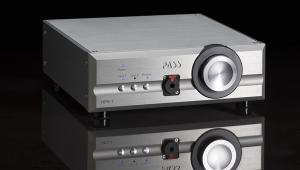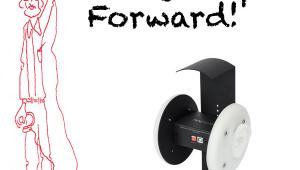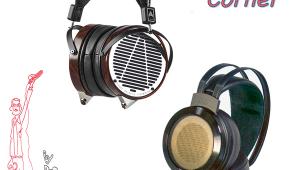| Columns Retired Columns & Blogs |
Katz's Corner Episode 8: My Current Affair

This story originally appeared at InnerFidelity.com
Editor's Note: As I read and edited this article an ever-increasing grin spread across my face as I realized it was Bob's geekspeak love note to Ti Kan and Morsel for their ledgend M3 DIY headphone amp. I'm sure they're both ticked pink at your praise, Bob.
It seems to me Bob's message here is: If you're a fairly accomplished DIYer, this is surely an amp to consider buildings.
This episode is full of ideas on what makes audio sound better (or worse). If you're like me, constantly searching for scientific reasons, you'll enjoy this episode. Join me in trying to make audible sense of it all.
My Current Affair
AMB M3 headphone amp. Nicely designed. Let's start with a feature I can speak of on pretty firm ground: It's DC-coupled. That was a very intentional choice on the part of Ti Kan and Morsel, designers extraordinaire, and probably the first buzz word in their description that caught my interest when I was choosing which amp to build.
DC coupled means that its frequency response extends down to the nether regions, 1Hz or below. But hey, we've been told we can only perceive down to 20Hz, right? The rest is subsonics, and we can't feel subsonics in headphones anyway, right? Even though both of those statements are pretty true, I still believe that having extreme low frequency response makes a serious difference to the sound of an amp, and how that low frequency response is extended makes a difference as well. I think that the sound in the officially-audible region (20Hz and above) is definitely affected by the response in the subsonic region. In this case it's not the quantity of the bass that results, but rather the quality.
What makes DC coupled amps sound better? Is it lack of phase shift? Is it lack of distortion by eliminating distortion-causing capacitors? If so, why not extend the response of every amp to DC, that shouldn't hurt, should it? But DC coupling might hurt...because DC offset (common in DACs) can cause clicks and pops, it can cause noises and distortion in potentiometers, and designers have been taught to try to avoid distortion, pops and clicks by employing coupling capacitors in their circuits sometimes to the point of overkill—sometimes you see one at every stage.
My philosophy is if you can replace two coupling caps with only 1, then do it. And if you can replace an output coupling cap with a DC servo circuit, then do it! If not, then no cap often sounds better than any cap, in my experience. But please don't go trying to take out caps from your amps willy-nilly, because there are good reasons for the majority of them, in a well-designed amp.
Over the years I've compared the sound of preamps that I've built or modified using big, high quality output capacitors versus those that don't use output caps at all. Every time, without exception, the output coupling cap blurs the bass definition. The cap never seems to help the sound; at best the cap is neutral or undetectable. A well-designed DC servo (which is an electronic replacement for a capacitor) can, however, maintain tight, deep bass without the sonic cost of a capacitor. Or, simply avoid coupling caps, if you accept the potential risk. So, I applaud Ti and Morsel's choice and I believe that DC coupling is a contributor to the sonics of the M3. I measured DC offset with no load, inputs shorted, as an insignificant 0.03 to 0.06 mV, a remarkable result for an amp without any DC servo, testament to the quality of the parts.
Another contribution to the sound of this amp is the Sigma 11 power supply. Power supplies can make or break the sound quality of an amp, so don't skimp on them. In my build, the Sigma 11 supplies 36 volts to the Mosfets, far more than necessary to sustain the desired output swing and current into a load, but for me, too much ain't enough! Using an oversize power transformer, this supply begins to stop regulating only when the line voltage sags to 97.8 volts. Again, overkill. The Sigma's paralleled MOSFETs keep the heat down, so there's no danger of burning up. Its output impedance is far lower than that of typical IC-based regulators, which results in a very tight bass. I believe the reason some "boutique" amplifiers sound spongey is that their power supply regulators do not have a low enough impedance.
Next, the designers provided a secondary regulation on the audio board to the opamps. This isolates the opamps from the outputs far more effectively than simple bypass capacitors. The secondary regulator drops the voltage to 34 volts, still permitting a significantly-high voltage swing. Even though we would not need that swing for ordinary, average musical passages, I believe that the additional headroom translates to greater impact of instantaneous transients and improved macrodynamics. Headroom. Potential energy. Overkill. Good design. Good for the ears.
Let's Be Discrete?
Speaking of opamps, "discrete" is currently in vogue, but in my opinion it is not necessarily the be-all, end-all that boutique amplifier designers would like you to think. Certainly AMB could have chosen to use some discrete opamp instead of a "run of the mill" integrated circuit. But it can be effectively argued that the OPA 627 IC which I chose is not your father's IC opamp. The 627 is a premium opamp with extremely high slew rate, open loop bandwidth, extremely low noise and other factors that mean things to geeks like me. It sounds very transparent; in fact it has little or no sound of its own.
It can be argued that this IC's lower distortion (lower than most discrete opamps) is what makes it sound so transparent. Some discrete opamps are so close to neutral that the touch of color they provide is what the doctor ordered, but based on my past listening and experimenting with several discrete opamps and shooting them out against the 627, I'm not convinced that "discrete" is a recipe for better sound all the time; the choice of opamp has to be considered in the context of the entire amplifier and signal chain. So skip the advertising buzz word, take a look at the whole circuit. Especially when one of the most important audiophile facts is that the combination of DAC, preamp, amplifier, interconnects and loudspeaker or headphone is far more important than the choice of any single component, no matter how superior a review it has gotten. If you pick a bright-sounding component to go with your bright speakers, you're in for trouble!
This point of view that discrete is not necessarily better could possibly offend some of my best friends, who have designed some of the best-sounding discrete opamps, but in my experience many of the discrete opamps I've tried are somewhat colored. Often due to their low open-loop bandwidth which does not permit much feedback and adds a certain "distortion du jour" effect (a nice color, hopefully).
Speaking of feedback, the M3 implements global negative feedback from the Mosfet output back to the opamp's negative input. Global negative feedback is often cited as an evil to be avoided at all costs, causing problems like a dry, closed-in, undimensional sound. Certainly not the characteristics of the M3! So I stand on the fence on the issue of feedback, which for many has become a religious concept at this point. I don't know enough to be able to say if it's always good or bad, but I do subscribe to Fred Forssell's assertion that you have to start with low distortion to begin with before you employ negative feedback. And given the known extra sweet harmonic character of Mosfets, perhaps the M3's global feedback tames enough of it to produce a wonderful, transparent, pure-sounding amp, in conjunction with the 627 opamp. I also think this amp sounds best to me with lots of feedback, 100% feedback at unity gain. As I mentioned in the previous episode, I think the amp gets a bit shallow at +10dB gain, which is accomplished by using 10dB less feedback! Don't ask me: I don't design 'em, I just listen and speculate.
If you want to investigate this point of view about opamp distortion, I suggest you read the impressive research paper by the talented designer and audiophile Samuel Groner: "Operational Amplifier Distortion". It's a very technical article meant for designers, but contains much light for DIYers.
Impedance, Polarity and Frequency Response
I calculated output impedance to about 0.2-0.3 Ohms. Given that my Fluke Ohmmeter sometimes tells me my 20 Ohm load is 20.5 and sometimes 20 Ohms depending on how tightly I squeeze the probes, there is some leeway in the impedance calculation. Polarity is non-inverting.
Next on order is flatness of response and high frequency bandwidth. I used my Prism Lyra 2 interface for all measurements at 192kHz sampling, to permit accurate measurements to almost 96kHz. Flat response is an attribute which we expect nowadays from solid state gear and the M3 is no exception. Measuring the preamp output, Room EQ Wizard reveals that the right channel of my build is an insignificant 0.02dB higher in level than the left. Low frequency response probably extends below the 10Hz point where I began to measure. In Room EQ Wizard, both channels of the preamp show a probably inaudible high frequency rise of less than 0.02dB from 10k to 20k, with response down less than 1dB to 50kHz.
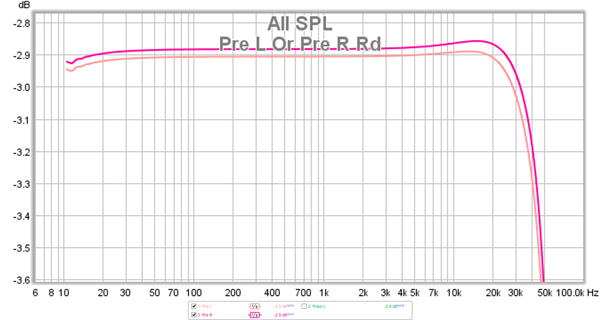
M3 preamp frequency response, left and right channel, using Room EQ Wizard.
Another measurement of the preamp, using Spectrafoo, reveals the high frequency extension, and if you look closely you'll see the tiniest visible increase at high frequencies—doubtfully audible. This is the left channel at +10dBu output. Notice that the Muses and TKD attenuators have identical response and extension at their 0dB position. It's flat from at least 16Hz through to being down about 0.3dB at 32kHz, and extends to -3dB at 64kHz. The phase response mirrors the frequency response.
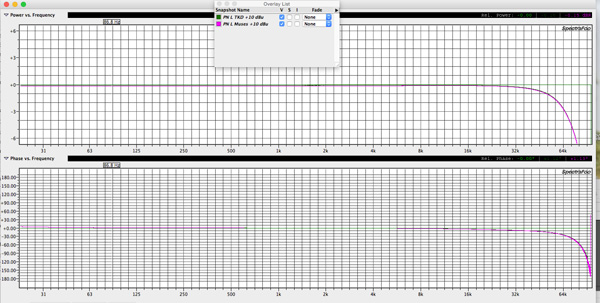
M3 preamp frequency response and phase, left channel, using Spectrafoo. TKD (blue) and Muses (red) attenuators match in frequency response in the 0dB position.
Noise and Distortion
You can never clip this amp at unity gain with a consumer DAC. Even the +18dBu (6.1 volt) maximum output of my Prism interface will not clip it. This is about 18dB higher than the output of a standard CD player! In order to clip the amp I had to engage the +10dB gain switch.
To evaluate distortion and noise, we have to conquer interface issues. An amplifier with a driven headphone common (active "ground") is especially difficult to measure without inducing hum or high frequency coupling from nearby sources, because we must not connect the input ground of the measurement interface to the amplifier or it could short and blow up an output device. I've got a capacitor on the shield, but still I am not entirely sure how much of the measured noise is caused by interfacing anomalies and how much is in the amp itself. Regardless, the amplitudes of noise and distortion being measured are probably so low as to ensure their inaudibility.
The next display shows the residual noise of the Prism interface (one channel) connecting its DAC output directly to its ADC input (in green) with a 1kHz tone at 0dBu. As you can see, it is very clean, just a little 2nd harmonic at -119dBu. Notice that the Prism interface noise rises from about 50kHz upward, which is caused by the noise shaping of the digital filters in the Prism's converters. This noise does not affect the frequency response measurement.
Overlaid is the headphone output of the M3 measured through the same interface, 1kHz at -14.8dBu, which would produce an SPL of 103dB in the Audeze LCD-X. At that level there is no detectable second harmonic from the M3. Notice the small hum at 60 and 180Hz and the high frequency anomalies almost certainly from RFI or other noise getting into the interface because I must not connect the ground of the Prism input to the driven "ground" of the M3. The shield is grounded through a capacitor which helps but not completely. The hum anomalies are at vanishingly low levels below -104dBu (5 microvolts), which mostly displays the resolving power of Spectrafoo and this interface, not anything which is the least bit audible. I'm pretty sure the hum is from my floating connection and not from the amp. Wideband signal to noise ratio (unweighted) of the preamp measures an excellent 86.9dB per channel at full gain (unity), or 78.7dB at the +10dB gain setting.
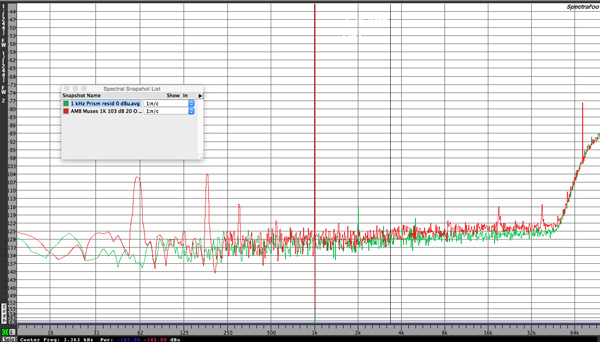
Prism interface 1kHz 0dBu DAC connected to ADC (green). M3 headphone output (red) 1kHz @ -14.8dBu, equivalent to LCD-X producing 103dB SPL. Scale is indBu.
In Episode #7 I mentioned that the Muses digitally-controlled analog attenuator appears to be sonically invisible/indistinguishable from a physical switched potentiometer made by TKD. The measurements seem to hold this out. It's mostly interesting that I can squeeze out some measurable differences at this incredible level of performance.
For example, in the next image, preamp output (left channel) displaying 19 and 20kHz mixed each at +10dBu. In blue, the preamp using the Muses digital pot, and in red, the TKD. Apparently in this image the TKD has more distortion than the Muses! But I blame the slight increase on the phase of the amp's distortion products combining with the distortion of the Prism. Note that the Prism itself produces measurable 1kHz difference product (-98dBu) and near 19kHz, so it's hard to say how much to blame on the amp. I suspect the amp contributes less distortion than the Prism itself. Never mind, I have nothing up my sleeve.
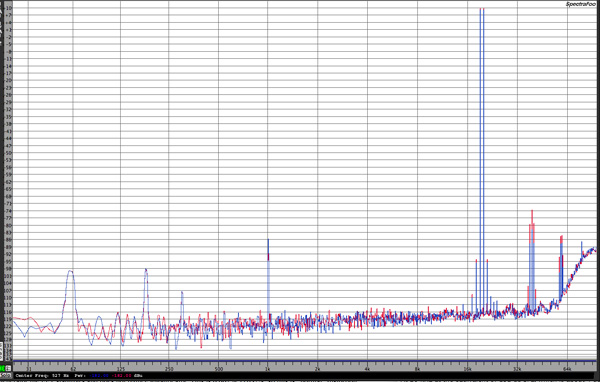
M3 preamp, 19 & 20kHz each at +10dBu. Muses digitally-controlled analog potentiometer, blue, TKD in Red. Ironically, the TKD appears to have more distortion than the Muses.
We can make the Muses attenuator give away its secrets by measuring both attenuators at extreme levels. Here is the preamp with a 1kHz sine wave at an extremely high output level of +18dBu (6.156 volts, a little below clipping). We can see that the Muses must be an active attenuator and the TKD is passive as the Muses distorts quite a bit more at these extreme levels.
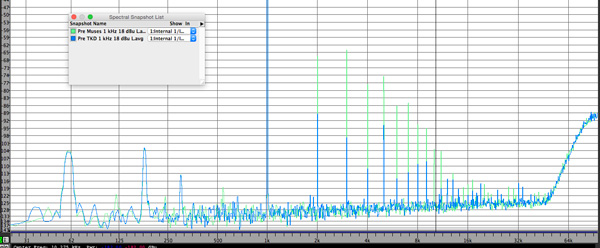
Preamp output (left channel), 1kHz at +18dBu, Muses attenuator in green, TKD in blue. Scale indBu.
We assume the TKD has zero noise floor for practical purposes and that the Muses is an active attenuator. We can deduce the noise floor of the Muses to some extent by playing with the attenuators and observing the output noise of the preamp. The noise with the Muses is constant at all attenuations. However, when I turn the TKD down all the way I can see about a 1dB reduction in noise, which must be coming from the Prism DAC. So the Muses noise is enough to obscure the noise of the Prism DAC. Mainly this curiosity indicates that the M3 preamp's noise is about the same as the Prism's state of the art DAC.
Next, these two distortion plots at an extreme +15dBu (4.3 volts) demonstrate that measurably the TKD attenuator is "cleaner" than the Muses. In other words, we can tell that the M3 preamp itself has very low midrange distortion only by using the TKD attenuator, but the Muses pot masks the preamp's distortion. Even so, we're talking about measurable differences near -90 and below -100dB below the fundamental!
For what it's worth, the preamp THD with the TKD measures 0.001% in the midrange while with the Muses, it's 0.002%. I don't think I can hear that difference, provided that the harmonic structure is benign. The squiggles above 10kHz are probably anomalies in Room EQ Wizard, which is really not designed to measure electronics, it's designed for speakers, which have much higher distortion. I wouldn't trust this measurement above 10kHz; besides, harmonics of fundamentals above 10kHz are in the supersonic range (20kHz and up). Foo says the preamp has a THD+N at 1kHz at 0dBu, 0.006 to 0.008%.
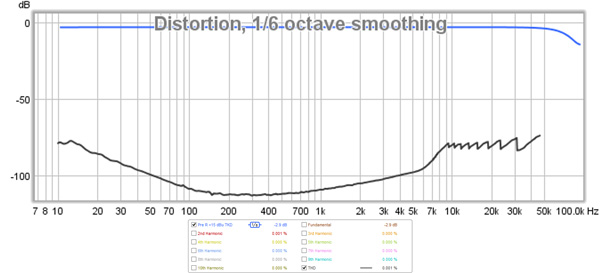
Preamp (right channel) at 15dBu, TKD attenuator set to 0dB. Midband distortion circa 0.001%.
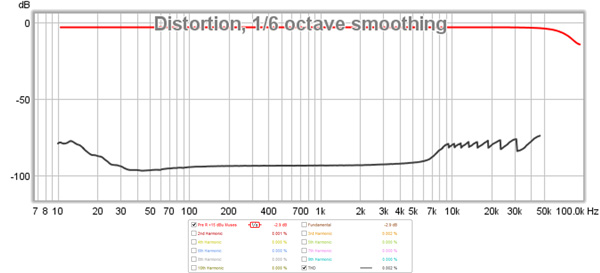
Preamp (right channel) at 15dBu, Muses attenuator set to 0dB. Midband distortion circa 0.002%.
The headphone output into a 20 Ohm load is as exemplary as the preamp. I have available distortion measurements at many frequencies and levels. Here is a sample of the M3 producing the equivalent of 100dB SPL into an Audeze LCD-X (I used a dummy load, don't worry!). Muses in green indistinguishably overlays the TKD in blue. The legend mistakenly says "103dB".
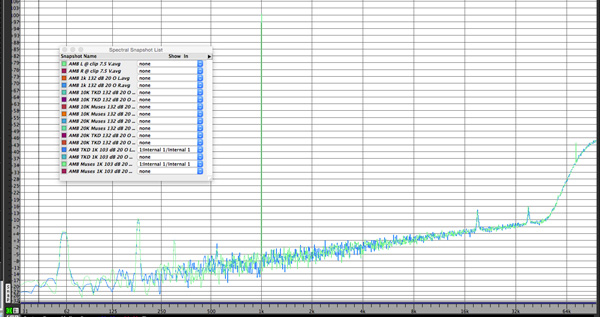
M3 headphone output noise at the equivalent of 100dB SPL at 1kHz, LCD-X into 20 Ohm load. Muses and TKD attenuators are overlaid but there is no measurable difference. Vertical scale is in equivalent SPL.
I have evaluated another digitally-controlled analog attenuator chip with similar measured rating (in the 0.006% THD range) that I consider sonically unacceptable. It sounds harsh to the ear. So the mystery lingers on and the only thing we do know is that an overall THD number is not a useful criterion for sonics. Much more important to the ear is the distribution of the harmonics and how they are masked by the noise and the signal.
Class In Session
I personally believe that Class A operation makes a sonic difference and improves purity of tone. This M3 is biased to be in Class A operation for a large part of its operating range. While the maximum output voltage just before clipping is nominally 7Vrms (sine wave), which is 2.45 watts, it would operate in Class AB at that level into a load. But with 105mA bias it still can operate Class A up to 0.882 watts into 20 Ohms, or 4.2 volts per channel, which is still quite respectable as that would produce 132.4dB peak SPL with the Audeze LCD-X phones!
Don't Get Cross
Next up is crosstalk (stereo separation). The preamp has remarkable crosstalk (stereo separation), left channel driven, right measured, of a remarkable -111dB at 1kHz, reducing to a still fantastic -86dB at 20kHz, into a high impedance load. This means that the opposite channel's signal is down in the noise floor—under normal circumstances it is completely inaudible and masked by the main channel.
The measured performance is nearly as good as a dual mono block preamp with independent power supplies and chassis. But I was puzzled when measuring the headphone output with a 20 Ohm load, that the crosstalk reduced to only -42dB at 1kHz! When I raised this point with my engineering expert, John Chester said, "of course, 46dB makes perfect sense because of the output impedance of the driven ground, which you calculated as 0.1 Ohm." Aha: Ohm's law! The lower the impedance of the headphones, the worse the crosstalk, because this is a driven ground system with a common "ground" that has a measurable output impedance. I then tested the headphone output without a load, and the stereo separation returned to about 100dB, confirming the laws of physics, as pictured here:

Four simultaneous test tones (20Hz, 1kHz, 10kHz, and 20kHz) are in the source channel, each at -4dBu (not shown). The opposite channel crosstalk is shown in blue when loaded by 20 Ohms. But when the amp is unloaded, the crosstalk at 1kHz (red trace) reduces to a remarkable -97dBu. See text.
But let's put these numbers in perspective. 46dB is still excellent stereo separation. It's probable that no one on earth can hear the difference between, say 40dB separation and 100dB. When phono cartridges were first introduced, they had a separation of 15dB, and eventually cartridges matured to around 20dB, which was considered excellent. 20dB is the difference between a shout and a whisper, so this M3 amplifier has over two shout-to-whisper ratios greater stereo separation than even the finest phono cartridge! I think it's not to worry. How much stereo crosstalk is acceptable in an amplifier? Probably anything better than about -30dB is audibly insignificant.
The only way that an amp with a driven ground could have better measured separation would be to have yet another ground channel (including another opamp and another pair of Mosfets) and to use a 4 pin "balanced" connector for the headphone output. I would be curious if such an amp sounds better than the M3, all other things being equal.
In Conclusion
And so we've come to the end of our story. Clearly, each of these sonic parts contributes a subtle improvement to the sound. What I think makes the M3 even more special is that the whole is greater than the sum of its parts.
In our next episode, I planned on evaluating some midpriced headphones, but instead I'm going to write about my fascinating experience with the Harman compensation curve. I have a number of bombs to drop that will blow your collective minds.
- Log in or register to post comments

